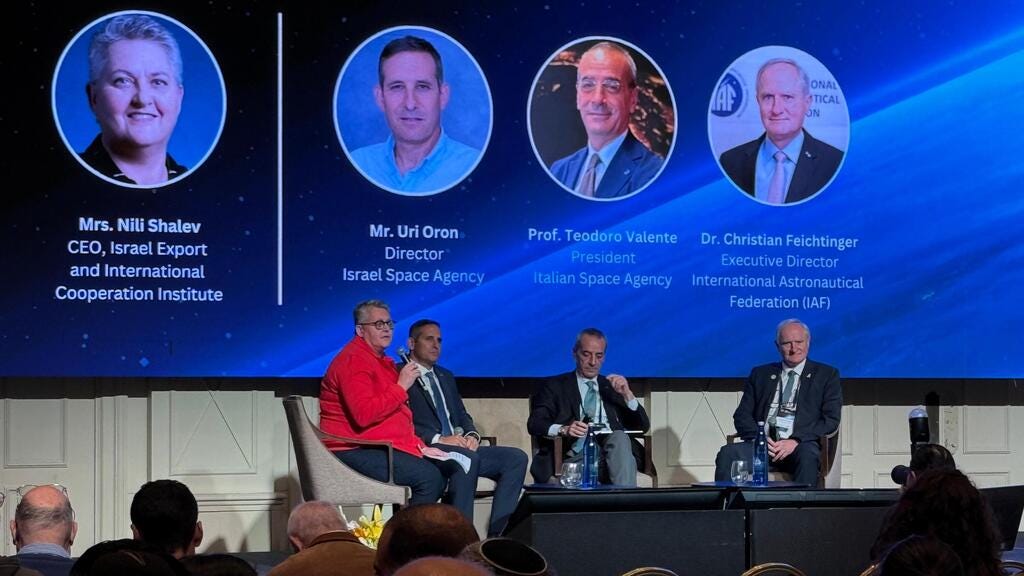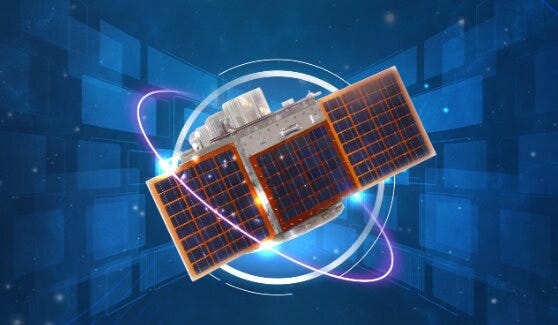Middle East Space Roundup: 27 January to 2 February 2025
A summary of all the space news in the Greater Middle East over the past week, brought to you by AzurX
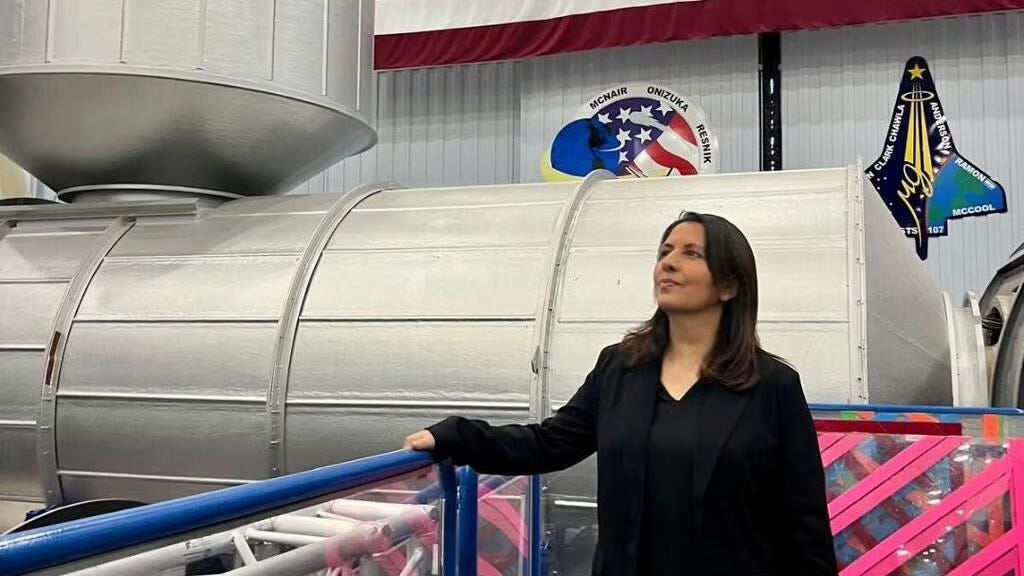
The following are the major space developments in the Greater Middle East region tracked by Middle East Space Monitor over the past week:
Israel Space Developments
Israel to Select First Female Astronaut for NASA Space Missions
Israel has secured NASA's approval to send its first female astronaut on a future space mission, marking a historic milestone in the country's space exploration efforts. Announced by Gila Gamliel, Israel's Minister of Innovation, Science, and Technology, at the Ramon Conference in Tel Aviv, the Israel Space Agency has initiated the candidate screening process, though specific details regarding the mission's timing and framework remain undisclosed. President Isaac Herzog highlighted Israel's growing prominence in the global space sector, emphasizing its leadership in advancing space technologies and fostering international collaborations, including with Abraham Accords countries. Minister Gamliel, during her visit to NASA’s Johnson Space Center, outlined plans to deepen cooperation with NASA, particularly in astronaut training, the Artemis lunar program, and International Space Station research. She also emphasized the importance of gender equality in STEM fields and called this initiative a continuation of the legacy of Ilan Ramon, Israel’s first astronaut. With ambitions to expand its space market to a 15-billion-shekel ($4.15 billion) annual turnover by mid-century, Israel is leveraging this milestone to inspire future generations, advance technological innovation, and strengthen its role in international space programs.
Israel and Italy Partner on SpaceIL’s Beresheet-2 Lunar Mission
The Israel Space Agency (ISA) and the Italian Space Agency (ASI) have signed a Memorandum of Understanding (MoU) to collaborate on SpaceIL’s Beresheet-2 mission, further solidifying Israel's role in lunar exploration. The mission, with a projected budget exceeding €10 million, aims to perform two Moon landings, conduct scientific experiments, and deploy a mother spacecraft to orbit the Moon for five years as a platform for global interactive scientific activity. This partnership will facilitate collaboration between Israeli and Italian researchers in areas such as navigation, communication, and landing sensors. ISA Director General Brig. Gen. Uri Oron highlighted Italy’s substantial experience and €1 billion annual investment in space as key assets for this collaboration. Beresheet-2 represents Israel's commitment to lunar exploration, following the initial Beresheet mission in 2019, which ended in a crash but succeeded in raising public interest and fostering STEM education. This mission aligns with renewed global interest in lunar projects, driven by geopolitical and scientific competition, including NASA's Artemis program and rival efforts from China and Russia.
Israel Space Agency DG: International and Commercial Cooperation Key to Israeli Space Success
Israel Space Agency (ISA) Director General Uri Oron has emphasized the necessity of global collaboration for Israel’s continued success in the space sector, arguing that independent efforts are insufficient for meaningful advancements. At the 20th Ilan Ramon International Space Conference in Tel Aviv, Oron highlighted that despite declining launch costs, space remains a highly complex field where partnerships—both governmental and commercial—are critical for efficiency, cost reduction, and technological breakthroughs. Israel’s space ecosystem, though relatively young and small, is growing rapidly, with approximately 105 space technology companies aiming to expand to 120, supported by a NIS 600 million ($166 million) government investment plan. A tangible example of this collaborative approach is ISA’s recently signed MoU with the Italian Space Agency for the Beresheet-2 lunar mission, with a budget exceeding €10 million ($10.4 million - see summary above). This mission will involve dual lunar landings and scientific exploration, reinforcing Israel’s role in international space research. Additionally, the upcoming Creation-Space accelerator program, set to launch in April 2025, will provide early-stage space technology companies with $250,000 in funding, fostering innovation and partnerships aimed at advancing both space exploration and Earth applications. As Israel continues expanding its satellite and remote sensing capabilities, Oron underscored that the country’s future in space hinges on integrating into the global space ecosystem rather than pursuing isolated initiatives.
Creation-Space CEO: Israel’s Contribution to Lunar and Mars Exploration
In The Jerusalem Post, Roy Naor, the CEO of Creation-Space, writes that the deep space market is set for a transformative year in 2025, driven by technological advancements, increased commercial investment, and renewed government interest in missions beyond Earth’s orbit. While traditional space powers like the U.S. and China remain dominant, private players such as Elon Musk and Jeff Bezos are increasingly shaping the industry. The resurgence of lunar resource extraction, Mars exploration, and even deep-space infrastructure projects marks a pivotal moment for countries like Israel, which has a track record of thriving in extreme environments. The election of Donald Trump and his support for human Mars exploration, coupled with the appointment of commercial astronaut Jared Isaacman as NASA Administrator, signals a shift toward greater private-sector involvement. Investors are increasingly backing dual-use technologies that support both space exploration and terrestrial applications, echoing the innovation cycle of the Apollo era. In this evolving landscape, Israel is positioning itself as a key player through a new innovation initiative launched during Israel Space Week. The Creation-Space program, based in Mitzpe Ramon, will invest in start-ups developing energy, construction, mining, and robotics solutions that address both Earth and space challenges. This initiative not only strengthens Israel’s space economy but also reinforces its global reputation as a technology leader, bridging the gap between terrestrial industries and the rapidly expanding deep space market.
U.S. Subsidiary of Israel’s Gilat Secures $4 Million Orders Military SATCOM Terminals
Israel’s Gilat Satellite Networks' U.S.-based subsidiary, Gilat DataPath, has secured $4 million in contracts from global defense clients for its CCT200, CCT120, and QCT90 portable satellite terminals. These orders, set for delivery over the next 12 months, reinforce Gilat DataPath’s reputation for providing robust and highly reliable SATCOM solutions for military operations. The company’s C-Series and Q-Series portable terminals are engineered to operate in extreme environments, meeting MIL-STD-810G standards while ensuring high-speed connectivity in challenging conditions. As defense organizations increasingly prioritize resilient and secure satellite communications, Gilat DataPath’s SATCOM solutions continue to be integral to mission-critical operations, further cementing its role as a key partner in global defense communications infrastructure.
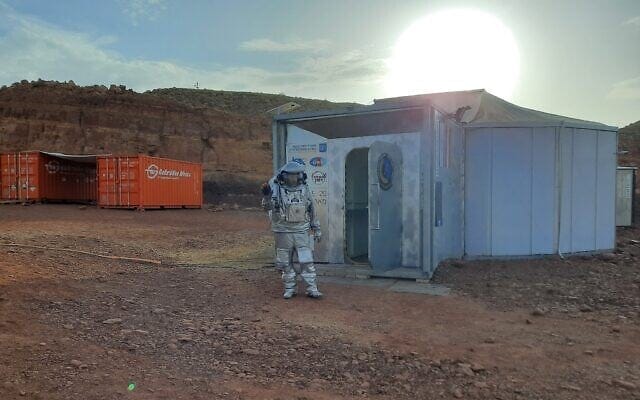
Israel’s Creation-Space Launches Space Ventures Accelerator Program for Space Startups
Israel’s Creation-Space is launching an accelerator program, Space Ventures, to support deep-space technology startups, aligning with global ambitions for human missions to Mars and the Moon. The program, which offers $250,000 investments, technical engineering support, and access to research facilities, seeks to develop critical technologies for extreme environments, including lunar infrastructure, energy conservation, automation, and robotics. Positioned in Mitzpe Ramon, a Mars-like terrain in Israel’s Negev Desert, the initiative aims to establish the region as a space innovation hub while fostering solutions applicable to both space and Earth, particularly in climate resilience. Creation-Space co-founder Dr. Roy Naor emphasized Israel’s strengths in problem-solving for deep-space challenges, citing existing expertise in desert adaptation technologies. The accelerator’s partners include major organizations such as Amazon Web Services, the Jewish National Fund-USA, and the Merage Foundation Israel. The program also aims to help Israeli startups secure NASA grants and collaborate with global space agencies. With recent U.S. commitments to Mars exploration, the initiative positions Israel as a key player in the emerging deep-space economy.
Israel Aerospace Industries Integrates GPS ADA Anti-Jamming System
Israel Aerospace Industries (IAI) has achieved a significant milestone by successfully integrating its ADA Anti-Jamming system with the M-Code GPS military receiver, enhancing resilience against evolving threats to satellite navigation. The ADA system, designed to protect GPS signals from Radio Frequency interference, demonstrated exceptional performance in both ground and flight tests, solidifying its reliability for military applications. IAI’s ADA portfolio is compatible with various Global Navigation Satellite Systems (GNSS) platforms and incorporates advanced digital signal processing algorithms to counter jamming and spoofing threats. With over 20 years of expertise in GNSS Anti-Jam solutions, IAI has integrated its navigation technologies across airborne, maritime, and guided munition platforms. IAI President and CEO Boaz Levy highlighted the system's adaptability to modern battlefield challenges, drawing parallels to the Arrow-3 missile defense system in terms of long-term operational relevance. Guy Barlev, EVP of IAI’s Systems, Missiles & Space Group, emphasized that the M-Code-enabled ADA system provides unmatched GPS immunity, ensuring assured Position, Navigation, and Timing (PNT) in contested environments. Given its combat-proven effectiveness and thousands of operational flight hours, this integration marks a crucial advancement in military navigation security.
UAE Space Developments
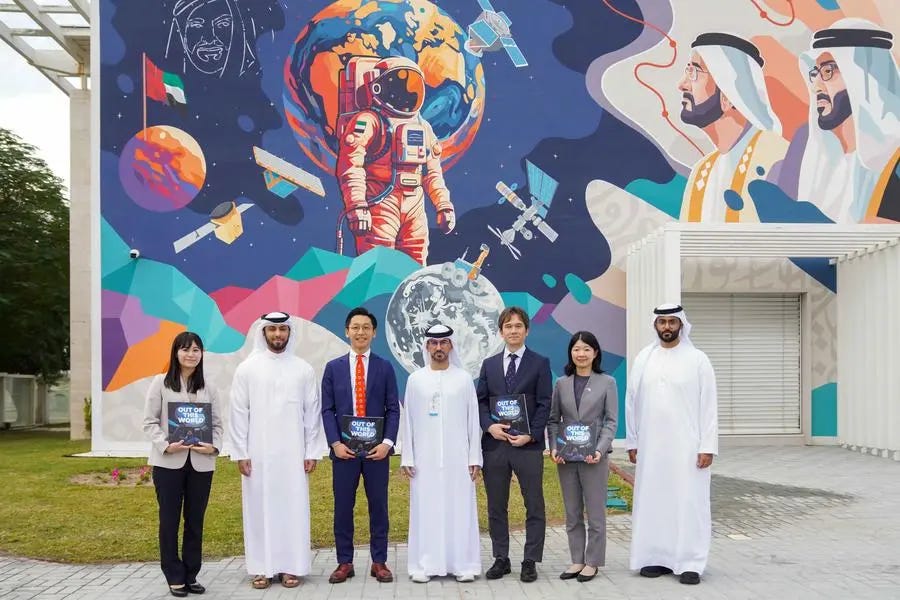
UAE’s MBRSC Partners With Japan’s SpaceData On Digital Twins for Space Missions and Urban Development
The UAE’s Mohammed Bin Rashid Space Centre (MBRSC) has signed an MoU with Tokyo-based SpaceData to develop advanced digital twin solutions for space exploration and urban development. For the Emirates Lunar Mission, SpaceData will create a high-fidelity lunar digital twin to enhance mission efficiency and astronaut training by simulating lunar surface conditions with three-dimensional spatial and environmental data. Additionally, SpaceData will develop a digital twin of Dubai to support virtual tourism, economic growth, and disaster prediction using satellite and meteorological data. This initiative aligns with Dubai’s urban development strategy by addressing climate challenges and improving safety. The partnership underscores MBRSC’s commitment to integrating cutting-edge digital technologies into space missions while leveraging space-derived innovations for economic and environmental sustainability.
UAE-Based Space Markets Launches World’s First Space Commodities Exchange
UAE-based company Space Markets has launched the world’s first onchain marketplace for space assets and commodities, creating a transparent and efficient marketplace for trading satellite spectrum, lunar resources, orbital station real estate, and other space assets. By tokenizing these resources and leveraging blockchain for secure transactions, Space Markets aims to democratize access to the space economy, which has historically been dominated by governments and select private entities. Key offerings include satellite spectrum trading, tokenized lunar and asteroid resource rights, and a marketplace for leasing or purchasing slots on private space stations. With the global space economy projected to surpass $1 trillion in the coming decade and increasing demand for orbital infrastructure and extraterrestrial resources, Space Markets, co-founded by entrepreneur Nick Trudgen, provides a regulated, high-liquidity platform for institutional and retail investors, space enterprises, and governments. This initiative marks a significant step in establishing a decentralized, borderless financial ecosystem for space-based assets, fostering innovation and sustainable growth in the emerging space economy.
Lockheed Martin Program Graduates 56 UAE Interns in Space, AI, and Defense Projects
Lockheed Martin has celebrated the achievements of 56 UAE interns at the third annual graduation ceremony for its Centre for Innovation and Security Solutions (CISS) internship program in Abu Dhabi. Since its inception in 2017, the program has evolved into a year-round initiative, reinforcing Lockheed Martin’s commitment to STEM education and Emirati workforce development. The 2024 cohort, comprising 37% women and 55% Emirati nationals, engaged in advanced projects spanning artificial intelligence, defense system simulation, and space exploration. Hosted by Gen. John Nicholson (U.S. Army, Ret.), Chief Executive of Lockheed Martin Middle East, and CISS Manager Hala Majeed Al Zargani, the event emphasized the importance of human capital in sustaining a knowledge-based economy. Nicholson highlighted the role of STEM talent in driving innovation and economic growth, while Al Zargani praised the interns’ technical expertise and problem-solving skills. As Lockheed Martin strengthens its Emiratisation efforts, plans are underway to expand the program’s training capacity, ensuring a steady pipeline of skilled professionals for the UAE’s aerospace and defense sectors.
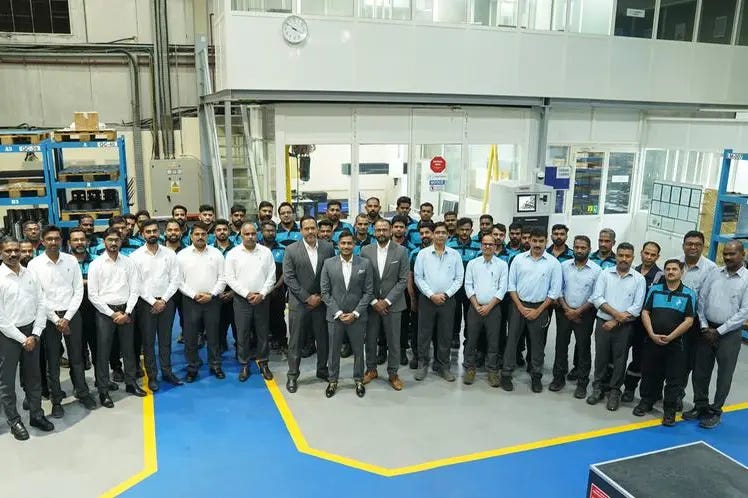
UAE Company Falcon Mechanical Group Contribution to MBZ-SAT Earth Observation Satellite
The successful launch of MBZ-SAT, the UAE's most advanced Earth observation satellite, marks a significant milestone in the country's growing space ambitions and highlights the impact of its "Make It In The Emirates" initiative. A key contributor to this achievement was Falcon Mechanical Group, a UAE-based precision engineering firm that supplied 90% of the satellite’s mechanical subsystems. This collaboration with the Mohammed Bin Rashid Space Centre (MBRSC) underscores the UAE’s strategic commitment to fostering homegrown expertise and self-sufficiency in space technology. Falcon Mechanical Group manufactured 2,520 precision-engineered components, meeting stringent astronautical standards through continuous innovation and advanced materials engineering. The MBZ-SAT project not only solidifies the UAE’s position in global space exploration but also showcases how local companies can drive high-tech advancements. Falcon’s evolution from aerospace repair services to a key player in satellite manufacturing highlights the UAE’s broader strategy of investing in precision engineering, space-grade manufacturing, and sustainable technological development. This success sets the stage for further advancements in the UAE’s space sector, strengthening its industrial capabilities and positioning local firms as competitive players in the global aerospace market.
UAE-Kazakhstan Deepen Geoeconomic, Space Collaboration
Kazakhstan’s deepening ties with the UAE were underscored during President Kassym-Jomart Tokayev’s working visit to the Abu Dhabi Sustainability Week (ADSW) Summit, where he emphasized the role of advanced technologies, including satellites, in tackling environmental and economic challenges. Kazakhstan's participation in the DEWA Space-D program, which leverages nanosatellites to enhance the operational performance of public utilities, aligns with its broader sustainability goals. The discussions between President Tokayev and UAE President Sheikh Mohamed bin Zayed Al Nahyan included agreements on strategic investments in space technology, artificial intelligence, and data centers, reflecting a shared commitment to innovation-driven economic growth. The UAE’s growing footprint in Central Asia, including investments in energy and logistics, positions Kazakhstan as a key partner in the Trans-Caspian International Transport Route (Middle Corridor), bolstered by satellite-based infrastructure and connectivity solutions. This evolving partnership exemplifies a broader geoeconomic realignment, strengthening Kazakhstan’s role in regional satellite applications while enhancing the UAE’s position as a global logistics and space technology hub.
Arab Health Announces UAE Winners of Astronaut Al Worden Endeavour Scholarships
Arab Health, the Middle East’s largest healthcare event, has announced the winners of the UAE’s inaugural participation in the Astronaut Al Worden Endeavour Scholarship, marking a significant step in the intersection of space and medicine. The five-member Emirati team, selected through a competitive process, will embark on a 10-day educational mission in the U.S., culminating in an immersive week at NASA’s Space Camp and Rocket Center in Huntsville, Alabama. This initiative, launched in 2019, reflects the UAE’s growing commitment to fostering scientific talent and space exploration. The program offers hands-on astronaut training, engineering challenges, and exposure to aerospace industries, reinforcing the link between healthcare and space research. Key figures such as Tom Kallman, Salem Humaid Al Marri, and former NASA astronauts emphasized the scholarship’s role in inspiring future leaders and advancing medical innovation beyond Earth. Arab Health’s involvement highlights the broader implications of space exploration for life sciences and human resilience, positioning the UAE as a leader in multidisciplinary scientific collaboration.
Türkiye Space News
Türkiye to Announce $2 Billion Investment Package for Space, Other Advanced Technology Development
Türkiye is set to announce a $2 billion high-tech investment package, reinforcing its ambitions in space and advanced technology sectors. Minister of Industry and Technology Mehmet Fatih Kacir confirmed that Türkiye plans to send a domestically designed and manufactured spacecraft to the Moon, leveraging its advancements in hybrid rocket motor technology. Türkiye ranks among the top four countries in this field and aims to validate its capabilities in space, potentially expanding into inter-orbital satellite transfers. The Moon mission’s initial phase will involve launching a satellite into lunar orbit for data collection and a soft-landing rehearsal. The initiative builds on Türkiye’s success with TURKSAT-6A’s post-launch orbital operations. Beyond space, the investment package will focus on industrial robotics, biotechnology, semiconductor production, and renewable energy technologies, positioning Türkiye as a leader in high-tech manufacturing. The country has already attracted nearly $7 billion in investments and remains the fastest-growing industrial producer among OECD countries over the past 22 years. The strategy aims to solidify Türkiye’s role as a competitive hub for space exploration, high-tech manufacturing, and next-generation mobility.
Türkiye: Report Alleges Fergani Space Contracts Bypassed Competitive Tender Processes
Türkiye has awarded the Uluğbey Project, a 100-satellite constellation initiative for global positioning, communications, and intelligence, to Fergani Space, a newly established company linked to Selçuk Bayraktar, President Erdoğan’s son-in-law, bypassing major state defense firms TUSAŞ and ASELSAN, according to Turkish online news site Turkish Minute. The decision, reportedly made without competitive bidding, raises concerns over transparency, competition, and efficiency in Türkiye’s growing space sector. Fergani Space launched its first domestically developed satellite, FGN-100-d1, aboard a SpaceX Falcon 9 launch vehicle on 14 January 2025, marking Türkiye’s largest private-sector satellite deployment to date. The company plans to establish a satellite launch base in Somalia, a move expected to reduce launch costs and expand Türkiye’s independent space capabilities. Industry sources suggest the project follows the government’s guaranteed payment model, ensuring long-term public funding for Fergani Space from institutions such as the Turkish Armed Forces, National Intelligence Organization, and General Directorate of Mapping. Analysts warn that sidelining established defense contractors could hamper innovation, inflate costs, and limit technological independence. The controversy follows previous cases where political favoritism influenced major defense projects, such as the Altay Tank and Karayel drone programs, which faced setbacks after government-backed firms were prioritized. Türkiye’s growing reliance on single-company space contracts could shape its satellite ambitions but also risk inefficiencies in a highly competitive global space market.

Türkiye to Increase 2025 Space Budget by 30 Percent to Achieve Space Ambitions
Türkiye is rapidly establishing itself as a significant player in the global space ecosystem, leveraging ambitious projects and strategic investments to enhance its technological and diplomatic standing, writes journalist Merve Ayşe Kızılaslan in the Daily Sabah. Recent milestones, including the launch of the indigenous FGN-100-d1 satellite and a Memorandum of Understanding (MoU) with Axiom Space to bolster supply chain opportunities, signal Türkiye's commitment to advancing communication, geospatial, and lunar exploration technologies. Guided by its "Century of Türkiye" vision, the country plans a 30% increase in its space budget for 2025, underscoring its determination to develop independent access to space, dominate the regional space market, and foster societal benefits through space-based applications. With 18 domestically produced satellites already launched and plans for a lunar mission to conduct scientific research, Türkiye is positioning itself as a contender in the international Moon and Mars exploration race. However, its share of active satellites remains below 1% globally, highlighting the competitive challenges ahead. As outer space increasingly intersects with international relations, Türkiye is navigating the complex dynamics of cooperation and competition to secure its interests, balancing partnerships with leading spacefaring nations and private actors while pursuing independent capabilities. These initiatives reflect Türkiye's strategic ambition to emerge as a pivotal spacefaring country in the evolving space age.
India’s Ambassador to Türkiye Calls for Greater Space Cooperation Between the Two Countries
India’s Consulate General in Istanbul marked the country’s 76th Republic Day with a reception attended by senior Turkish officials and diplomats, highlighting strengthening bilateral ties. Ambassador Muktesh Pardeshi emphasized India’s ambition to double trade with Türkiye, which has fluctuated around $10 billion annually, by addressing market access and tariff barriers. He also underscored India’s rapid advancements in space technology, citing achievements such as its 2023 uncrewed Moon landing and recent space docking milestone, making India the fourth country to achieve this feat. Pardeshi highlighted India’s cost-effective approach to space programs and suggested growing potential for space collaboration between Türkiye and India, positioning it as a promising sector for future bilateral cooperation.
Iran Space News
Report: Iran Using Its Spaceports to Develop Nuclear Warheads
A recent report suggests that Iran is leveraging its space program to advance its nuclear weapons capabilities, with covert activities linked to the Organization of Defensive Innovation and Research (SPND) operating within key space launch facilities. The report indicates that Iran’s Shahroud Space Center and Imam Khomeini Spaceport—both previously associated with satellite launches—are now housing nuclear warhead development efforts under the oversight of the Islamic Revolutionary Guard Corps (IRGC). The Shahroud facility, known for developing the Ghaem-100 solid-fuel rocket, has reportedly been repurposed for missile-based nuclear warhead integration, with sources alleging that the missile design was derived from North Korean technology. Meanwhile, the Imam Khomeini Spaceport, which recently launched Iran’s heaviest-ever rocket, is suspected of advancing liquid-fuel propulsion technologies that could enhance Iran’s long-range missile capabilities. The National Council of Resistance of Iran (NCRI) report warns that these developments suggest Iran is moving beyond uranium enrichment—already at near-weapons-grade levels—toward the assembly of functional nuclear warheads and their delivery systems. The International Atomic Energy Agency (IAEA) has confirmed Iran possesses sufficient enriched uranium to construct multiple nuclear bombs if further refined. These revelations underscore growing concerns that Iran’s space program serves as a strategic cover for military advancements, posing significant geopolitical and security risks for the region and beyond.
Iran Unveils Three Satellites in National Space Technology Day
Iran marked its National Space Technology Day with the unveiling of three domestically developed satellites—Navak-1, Pars-2, and an upgraded version of Pars-1—highlighting its continued advancements in satellite technology. The event, attended by President Masoud Pezeshkian and ICT Minister Sattar Hashemi, showcased Iran’s growing capabilities in telecommunications and Earth observation. Navak-1, a 34 kg telecommunications satellite, is designed to test the optimized Simorgh launch vehicle and features instruments for measuring space radiation and Earth’s magnetic field. The 150 kg Pars-2 satellite, developed entirely in Iran, is equipped with two imaging payloads for applications such as environmental monitoring, disaster management, and urban planning. The upgraded Pars-1 enhances Iran’s remote sensing capabilities with multispectral, short-wave infrared (SWIR), and thermal infrared (TIR) sensors, supporting advanced Earth observation functions. These developments underscore Iran’s efforts to expand its space capabilities, despite international sanctions, positioning itself as a key regional player in satellite technology.
Iran’s President Pezeshkian Reaffirms Country’s Space Ambitions
Iran’s President Masoud Pezeshkian marked National Space Technology Day with a visit to the Iranian Space Agency, where he reviewed the country’s latest defense and space advancements, including the Simorgh satellite launch vehicle. Accompanied by senior officials, Pezeshkian emphasized that Iran's growing military and space capabilities are intended for self-defense and deterrence rather than aggression. He credited Iranian scientists and engineers for driving innovation in defense and aerospace, reinforcing the country’s technological self-sufficiency despite international sanctions. Pezeshkian reaffirmed Iran’s commitment to expanding its space ambitions, stating that the country aims to conduct flights beyond Earth's atmosphere, further solidifying its standing in global space endeavors. His remarks underscored Iran’s strategic focus on indigenous development in space and military technology, positioning the country as both a producer and exporter of advanced defense systems.
Iran’s Defense Minister Suggests Launching Satellites of Other Countries
Iran’s Defense Minister Brigadier General Aziz Nasirzadeh highlighted the country’s advancements in satellite launch vehicle (SLV) technology, suggesting that Iran may soon provide launch services to allied countries. Speaking at an exhibition of the Defense Ministry’s achievements, he emphasized Iran’s collaboration with over 7,000 private firms and 300 knowledge-based enterprises to enhance its space capabilities. Iran’s decision to develop indigenous satellite launch vehicles stemmed from challenges in launching homegrown satellites, leading to its current maturity in the field. Nasirzadeh announced plans for two satellite launches by mid-February 2025 and outlined Iran’s progress in space tugs, which will facilitate access to Geostationary orbit (GEO). Additionally, he revealed ongoing work on the Sarir SLV, designed for heavy payloads, signaling Iran’s broader ambitions in the global space industry.
Iran’s National Space Technology Day Commemorates Space Achievements in Face of Western Sanctions
Iran’s National Space Technology Day, commemorating the 2009 launch of its first domestically built satellite, Omid, serves as a platform to showcase the country’s expanding space capabilities despite international sanctions. The Iranian Space Agency (ISA) has announced significant advancements, including 25 satellites under development, improved imaging precision to two meters, and the integration of AI in satellite operations. Iran recently launched three homegrown satellites—Mahda, Keyhan-2, and Hatef-1—reaching elliptical orbits up to 1,100 km, a strategic step toward achieving geostationary orbit (GEO). On February 2, 2025, Iran will unveil additional satellites, including Paya, Zafar-2, and Pars 1 & 2, underscoring its progress in remote sensing and communications. The country is also advancing bio-space technology, with plans for a 1.5-ton capsule capable of human missions. Iran’s broader space ambitions include launching more satellites and positioning the Chabahar Spaceport as a regional launch hub. Despite geopolitical challenges, Iran ranks among the top 12 countries with independent satellite launch capabilities, reinforcing its strategic push for space self-sufficiency and technological sovereignty.
Iran’s Space Chief: 25 Satellites Currently Under Development, Chabahar Spaceport to be Operational by Mid-2025
Iran is accelerating its space program with 25 satellites currently under development and plans to launch two by the end of the Islamic year (March 2025), according to Iranian Space Agency (ISA) chief Hassan Salarieh. Iran's satellite capabilities have evolved from low-resolution imaging to platforms with two-meter accuracy, with ongoing advancements integrating artificial intelligence (AI) for enhanced data processing. The unveiling of new satellites, including Paya, Zafar-2, and Pars 1 & 2, is set for National Space Technology Day on 2 February 2025, underscoring the country's commitment to expanding its domestic space capabilities. Additionally, Iran is advancing its Chabahar Spaceport, positioned along the Makran Coast, as its primary satellite launch facility, with plans to offer launch services to international clients. The spaceport’s first phase is expected to be operational by mid-2025, potentially positioning Iran as a regional launch provider despite ongoing geopolitical concerns surrounding its space and missile technology developments.
Iranian Opposition: Starlink Poses Significant Challenge to Regime
The rise of satellite internet, particularly SpaceX’s Starlink, poses a significant challenge to Iran’s longstanding digital censorship regime, writes Mahmoud Hakamian for the Iranian opposition group National Council of Resistance of Iran (NCRI). Unlike traditional internet services controlled by state-owned ISPs, satellite internet bypasses government restrictions, offering Iranian citizens direct access to uncensored information. Reports suggest that over 30,000 Iranians are already using Starlink despite government crackdowns, which include criminalizing satellite internet usage, seizing equipment, and attempting to jam signals. However, technical limitations hinder the regime’s ability to block satellite connections, as encryption advancements make detection increasingly difficult. This shift threatens Iran’s control over online discourse, particularly during periods of civil unrest, where authorities have historically relied on internet blackouts to suppress dissent. The widespread adoption of satellite internet could mark a turning point for digital freedom in Iran, as protesters, journalists, and human rights activists leverage the technology to counter state propaganda and communicate globally. Iran’s struggle to contain this decentralized and resilient technology highlights broader concerns for authoritarian regimes worldwide, signaling a potential digital revolution that could erode state-controlled information barriers.
Saudi Arabia Space Developments
Saudi Arabia’s Aramco Enhances Partnership With GHGSat to Monitor Methane Emissions
Saudi Arabia’s Aramco has partnered with GHGSat, a leader in satellite emissions monitoring, to enhance methane detection and mitigation across its operations, as reported by Khalid Y. Al Qahtani, Aramco Senior Vice President of Engineering Services, in the World Oil publication. Building on a successful pilot program, Aramco Americas contracted GHGSat to monitor methane emissions using advanced remote-sensing satellites, improving leak detection and response capabilities. Methane, a potent greenhouse gas, has a higher global warming potential than CO2, making its reduction a strategic priority in Aramco’s goal to achieve net-zero Scope 1 and Scope 2 emissions by 2050. The integration of satellite-based monitoring complements Aramco’s existing leak detection efforts, offering high-resolution, frequent observations that improve mitigation strategies. This initiative aligns with global methane reduction commitments, including Saudi Arabia’s participation in the Global Methane Pledge and Aramco’s endorsement of the World Bank’s Zero Routine Flaring by 2030 initiative. The company also actively participates in decarbonization efforts such as the Oil and Gas Decarbonization Charter and the Aiming for Zero Methane Emissions Initiative. With satellites enhancing its methane monitoring program, Aramco continues to refine its emissions reduction strategy, reinforcing its leadership in sustainable energy practices.
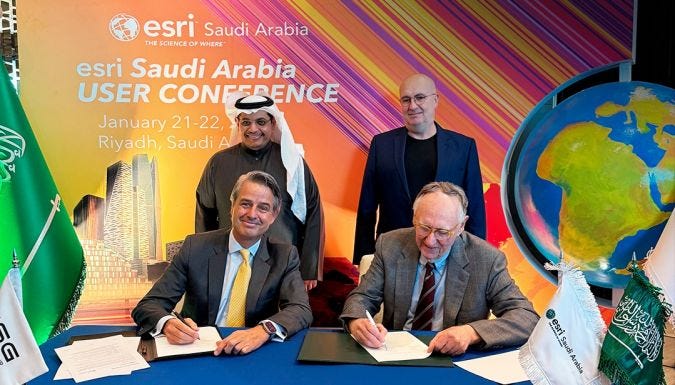
Saudi Arabia’s Neo Space Group Signs Geospatial MoU With Esri
Esri has signed a Memorandum of Understanding (MoU) with Neo Space Group (NSG), Saudi Arabia’s leading commercial space services provider and a Public Investment Fund (PIF) company, to advance the geospatial sector in alignment with Vision 2030. Announced at the Esri Saudi User Conference 2025, this partnership will integrate NSG’s expertise in geospatial services with Esri’s cutting-edge GIS technology to drive innovation across key sectors, including agriculture, defense, security, environmental monitoring, and urban planning. A core focus of the collaboration is research and development (R&D), talent development, and leveraging Earth observation data to provide actionable insights for sustainable development. Additionally, NSG and Esri will launch specialized training programs and workshops to build expertise in geospatial intelligence. With geospatial technologies emerging as a critical pillar of Saudi Arabia’s economic diversification strategy, NSG is positioning itself as a leader in satellite communications, positioning, navigation, and timing (PNT) solutions, supporting the Kingdom’s broader ambitions to develop a world-class space ecosystem.
Expert: Saudi Arabia’s Use of Space and Satellite Technology for Public Health Monitoring
In Arab News, Dr. Farhan M. Asrar writes that space technology is emerging as a critical tool in addressing climate change and its health impacts, as highlighted during COP28 in Dubai, where 20 space agencies convened for the first Space Agencies Leaders’ Summit on climate solutions. Satellites and remote sensing technologies provide essential data for tracking air pollution, greenhouse gas emissions, and extreme weather events, aligning with global efforts like the Space for Climate Observatory, which includes the Saudi Space Agency among its 45 signatories. Saudi Arabia, highly vulnerable to rising temperatures and environmental stressors, is leveraging space-based monitoring to support climate resilience and Vision 2030's sustainability goals. A recent study, co-authored by NASA Earth scientist Dr. Helena Chapman, highlights how space data can advance the One Health Initiative, addressing the interconnectedness of human, animal, and environmental health. The research emphasizes three key areas where space technology plays an innovative role: air quality and pollution control, monitoring infectious disease outbreaks, and early warning systems for climate-related disasters. Saudi Arabia is already integrating satellite data into environmental management, with opportunities to further enhance climate monitoring, emissions tracking, and clean energy initiatives. Additionally, space-driven innovations designed for long-duration missions could contribute to healthcare advancements in the Kingdom. As climate change continues to pose global health threats, cross-sector collaboration—including efforts from healthcare institutions, academics, and policymakers—is essential for developing space-enabled climate solutions and driving sustainable progress.
Egypt Space News
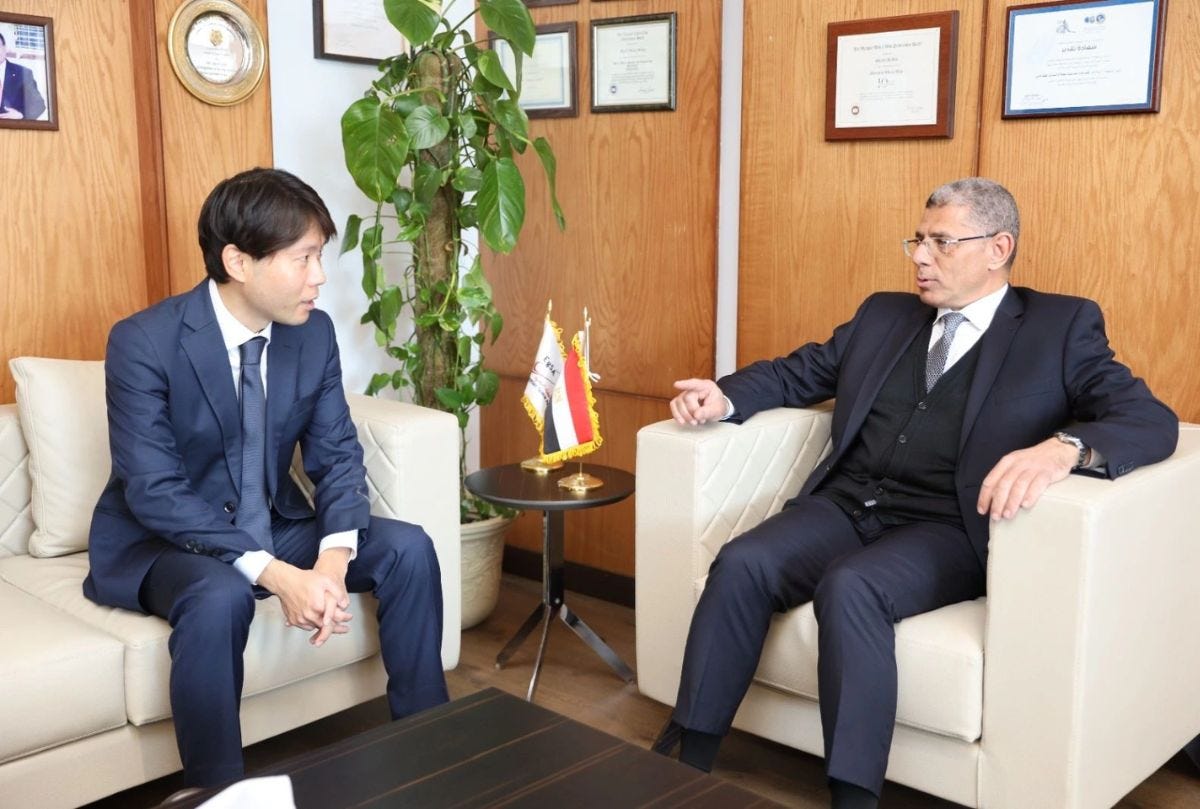
Egypt and Japan Discuss Strengthening Bilateral Space Cooperation
The Egyptian Space Agency (EgSA) hosted a high-level delegation from the Japanese Embassy in Egypt, led by Economic Advisor Mr. Suzuki Yusuke, to discuss strengthening bilateral cooperation in space technology. During the 23 January 2025 visit, Dr. Sherif Sedky, CEO of EgSA, emphasized the importance of leveraging shared expertise to enhance collaboration between Egypt and Japan. The meeting included discussions with EgSA's senior management on advancing joint initiatives, followed by a tour of critical facilities such as the Assembly, Integration, and Testing Center (AITC) and the control and image reception station for the MisrSat-2 Earth observation satellite. This engagement underscores EgSA's commitment to fostering international partnerships and advancing its space technology capabilities to support national and global sustainable development goals.
Egypt and Kenya Deepen Strategic Cooperation in Space Technology
The Egyptian Space Agency (EgSA) has strengthened African space collaboration by hosting a high-level delegation from the Kenya Space Agency, led by CEO Brigadier Hilary Kipkosgei. The visit, aimed at deepening strategic cooperation, focused on satellite technology, technology localization, and human capacity building. During bilateral discussions at EgSA headquarters, CEO Dr. Sherif Sedky emphasized the importance of integrating expertise in Egypt and Kenya to advance Africa’s space agenda. As the host of the African Space Agency’s permanent headquarters, Egypt is positioned to drive unified space initiatives across the continent, reinforcing regional cooperation and fostering a more coordinated approach to space development.
Other Regional Space Developments

China Makes Inroads Into Oman’s Space Program
China’s growing presence in the Middle East’s space sector is highlighted by its recent satellite collaboration with Oman. At the start of 2025, China Great Wall Industry Corporation (CGWIC) successfully delivered the IRSS-1 remote sensing satellite to the Omani company, Oman Lens. Launched in November 2024, the satellite enhances Oman’s capabilities in land surveys, urban planning, and disaster monitoring, marking a significant step in the country’s satellite applications. Meanwhile, Chinese companies are expanding satellite communications in the region, with Geespace, a subsidiary of Geely, completing its first commercial deployment test in the Middle East in mid-2024. The company aims to offer satellite-based communication and high-precision positioning services across the region, reflecting China’s broader strategy to integrate its satellite networks into global markets. Additionally, China’s Chang Guang Satellite Technology Co Ltd is strengthening its global remote sensing services, with its Jilin-1 constellation supporting international clients, including emergency response operations in coordination with the United Nations. These developments illustrate the Middle East’s increasing role in China’s commercial satellite expansion, as regional states seek advanced space capabilities while diversifying partnerships beyond traditional players.
Syria: Illegal Use of Starlink SATCOM Exposes Country’s Outdated Communications Infrastructure
Following the fall of the Syrian regime on 8 December 2024, Aleppo residents have faced deteriorating internet services, leading many to seek alternatives such as Starlink satellite internet. Previously banned under the former government in Syria, Starlink has become increasingly sought after despite regulatory uncertainty. The Communications and Postal Regulatory Authority has warned that unauthorized possession and distribution of satellite internet devices remain illegal, though exceptions may be granted for remote areas. The high demand has created a fragmented market with varying prices; devices are being sourced from other provinces, with costs ranging from $830 to $1,350 depending on installation and activation services. Subscription fees also fluctuate, with some providers charging a $100 monthly fee. The uncertainty surrounding potential taxation further complicates Starlink’s adoption. Meanwhile, Syria's internet infrastructure remains outdated, relying on decades-old ADSL technology. The Damascus interim government has acknowledged the sector's shortcomings and introduced new licensing regulations for internet service providers to prevent the resurgence of companies tied to the former regime. The rising demand for satellite connectivity underscores the urgent need for telecommunications reform in Syria.
Morocco to Host Inaugural Africa-Middle East Space Conference 5 to 8 February
Morocco will host the inaugural Africa Middle East Space Conference (AMESC 2025) from 5 to 8 February 2025 at the Mohammed VI Polytechnic University in Rabat, aiming to connect emerging space players with global leaders. Organized by the Moroccan Initiative for Space Industry (MISI), the Aerospace Moroccan Cluster (AMC), and the Islamic World Educational, Scientific and Cultural Organization (ICESCO), with support from Morocco’s Ministry of Industry and Trade and the U.S. Embassy, the event will emphasize cross-border collaboration in space exploration and innovation. Participants include major space agencies such as NASA, ESA, ASI, EgSA, Azercosmos, and the Kenya Space Agency, alongside organizations like UNOOSA, Arizona State University’s MILO Institute, and Abu Dhabi’s Technology Innovation Institute. Former NASA astronaut Dorothy Metcalf-Lindenburger will speak on her experiences aboard the ISS. The conference will cover critical topics, including space policy, partnerships, investment, climate-focused Earth observation, space medicine, and workforce development, reinforcing Morocco’s role as a strategic hub for regional space cooperation.
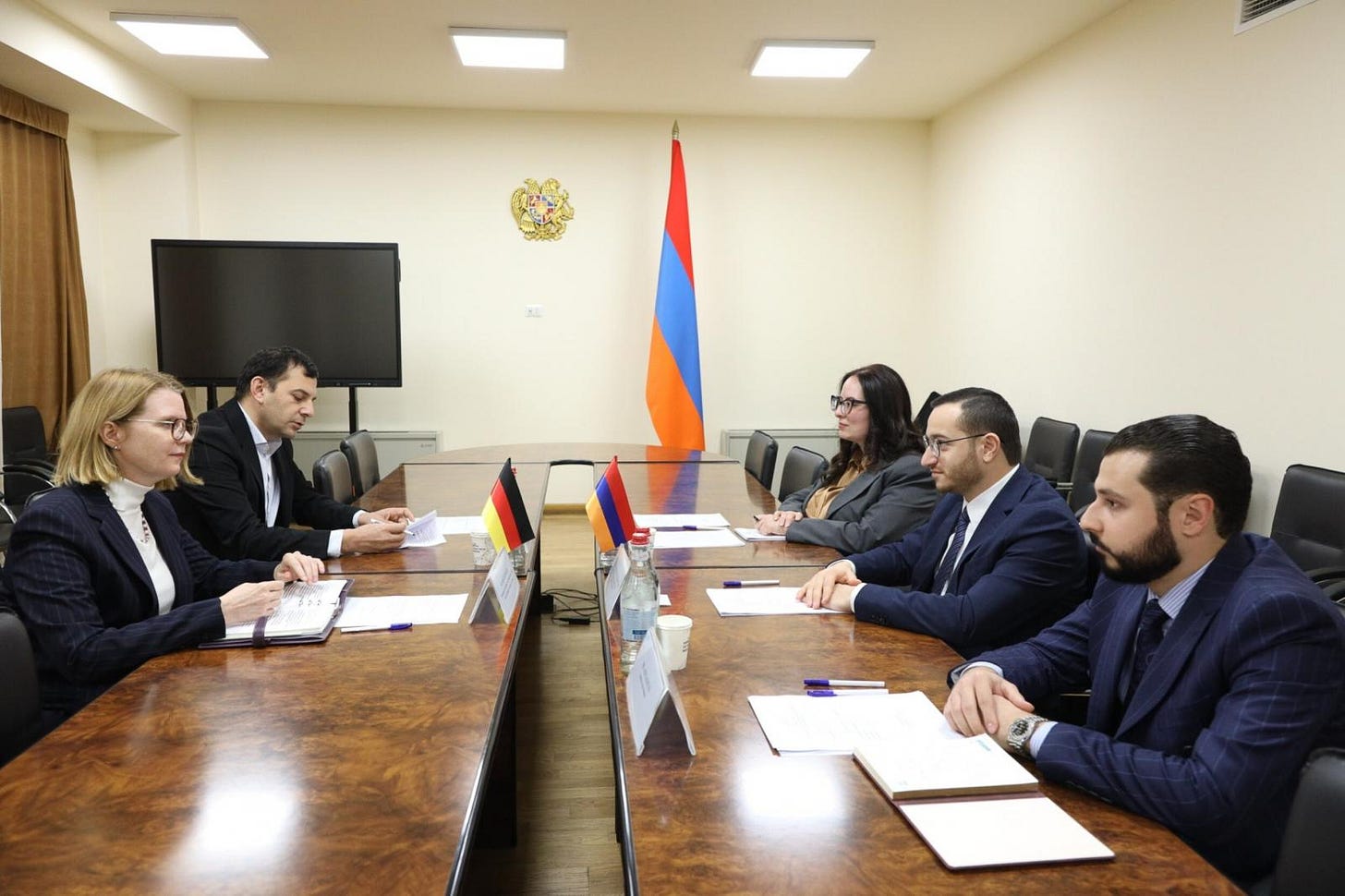
Armenia and Germany Discuss Technology Cooperation, Including Space
Armenia's Minister of High-Tech Industry, Mkhitar Hayrapetyan, met with Germany’s Ambassador to Armenia, Claudia Bush, to explore avenues for bilateral technological cooperation. The discussion centered on Armenia’s strategic priorities, including high technologies, digitalization, space technologies, and cybersecurity, as well as the country’s newly launched seven-year program for technological sector development. Both parties emphasized the importance of attracting major German and EU-based IT companies to Armenia, fostering investment and innovation. Ambassador Bush reaffirmed Germany’s commitment to deepening cooperation, particularly in capacity development, startup ecosystems, and the broader tech industry, aligning with Armenia’s efforts to position itself as a regional technology hub.
U.S. Iron Dome for America: Implications for the Middle East
U.S. President Donald Trump has issued an executive order calling for a next-generation missile defense system, dubbed the “Iron Dome for America,” with a significant space-based component. Unlike Israel’s Iron Dome, which intercepts short-range threats, Trump’s initiative aims to revive aspects of the Reagan-era Strategic Defense Initiative (SDI), or "Star Wars," to counter ballistic, hypersonic, and cruise missile threats. A key element of the plan involves expanding the Proliferated Warfighter Space Architecture (PWSA) — a network of hundreds of optically connected satellites capable of tracking hypersonic missiles and cruise missiles flying at low altitudes. With 27 satellites already in orbit out of a planned 500, these systems will work alongside existing U.S. capabilities, such as the Space-Based Infrared System (SBIRS), which provides early warning for missile launches. The initiative also mandates a review of theater missile defenses for U.S. forces and allies, which could extend to the Middle East, where satellite tracking and missile interception systems like THAAD and Aegis already play a role. Trump’s order also references space-based interceptors, potentially reviving the abandoned Brilliant Pebbles concept—1,500 small satellites designed to engage missiles during their ascent phase. With potential implications for allied countries, including those in the Middle East, the directive signals a major shift toward leveraging space-based systems for missile defense, further enhancing the role of the U.S. Space Force in global security.
Report: GCC Countries Emerge as Leading Space Powers
In COMMSMEA Anita Joseph writes that Gulf Cooperation Council (GCC) countries are rapidly emerging as leaders in satellite and space exploration, leveraging transformative investments and visionary strategies to drive technological innovation and societal evolution. Groundbreaking initiatives like the UAE’s Hope Probe, Saudi Arabia’s Vision 2030 space programs, and Qatar’s Es’hailSat demonstrate how space research has become a strategic pillar of national development, shaping economies, empowering communities, and fostering regional pride. These programs are underpinned by robust policies, regulatory frameworks, and significant government funding, such as the UAE’s $820 million commitment to the Hope Probe and Rashid Lunar Rover, and Saudi Arabia’s $2.1 billion allocation to space initiatives. Beyond technological advancements, space exploration is driving societal change by inspiring STEM careers, promoting gender equality, and enhancing connectivity for underserved communities. Satellite technologies are also addressing critical challenges, including climate change, disaster management, and cultural heritage preservation, while enabling commercial opportunities like satellite communication, smart cities, and space tourism. As the GCC continues to expand its space ambitions, prioritizing private-sector collaboration, regional partnerships, and sustainable policies will be essential to solidify its position as a global space power.
Other regional news in brief:
Oman and India held trade talks in Muscat, where among other topics space research cooperation was discussed.
Be sure to catch up with space activities in the region in the next edition of Middle East Space Monitor’s space roundup!




